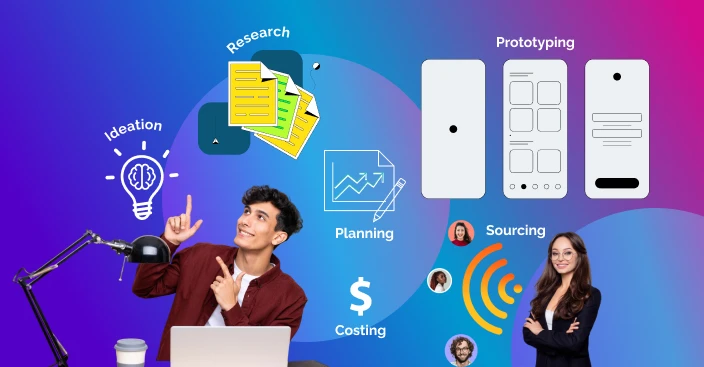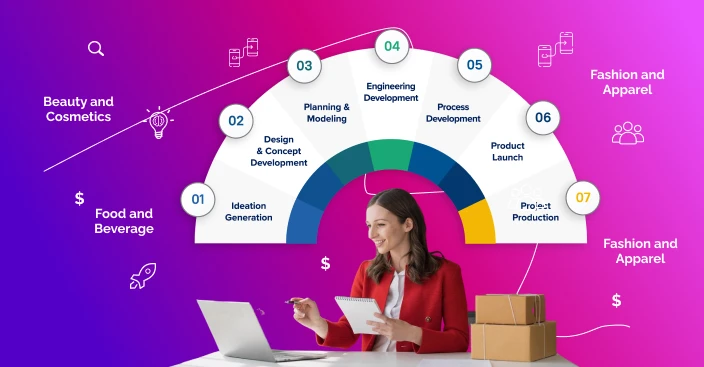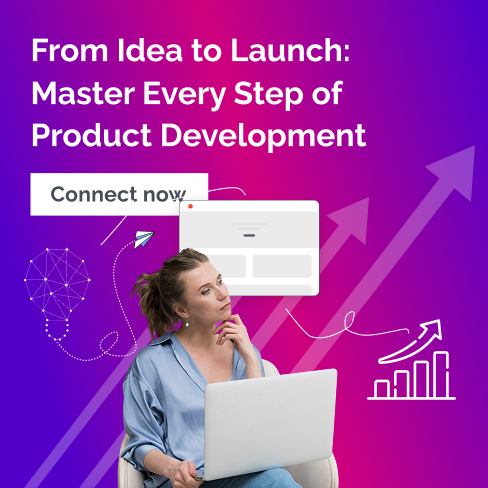Product Development – Definition and Processes – All You Need to Know

One of the most critical processes for establishing new businesses, the product development process is often a mystery. The journey from origin to the creation of even the best products in the market seldom follows a straight-line trajectory.
Most of these stories are filled with challenges, hurdles, and further improvisations down the path. Recent studies show product development remains risky: 70% of projects still fail, 90% of consumer‑packaged goods vanish within a year, and only 20% of new products survive past year two.
The development stories, on their own, do not provide insight into the course of the product journey, but some of the steps taken can be used to establish a product creation path.
This trajectory is based on the similarities between the nature of the measures adopted by the founders during the development of products across different product categories.
Before we understand the different steps in product development, let’s first define what product development is.
What is product development?
The process of new product development is defined as the one that results in bringing an original idea for a product into the market. Although the procedures vary across different industries, the core steps behind the process are usually the same across various product categories. These steps can be broken down into:
- Ideation
- Research
- Planning
- Prototyping
- Sourcing
- Costing
Now, let us examine the above steps in detail and analyze the process of developing an idea, including the key considerations at each stage.
Steps behind the product development process:
1. Ideation:
A majority of the entrepreneurs tend to get stuck at this very stage most of the time because they are usually waiting to find the perfect product that they should be selling in the market.
Building a product that is entirely new in the market can be a great idea, which is also creatively fulfilling. Even then, the best business models usually result from entrepreneurs improving upon the already-existing products in the market.
The SCAMPER model can be a useful tool in guiding companies to generate product ideas quickly. This model is based on these entrepreneurs asking questions about the presence of some existing products in the market.
In this model, each of the initials represents a specific step. Let’s examine some product development examples in each of the categories.
- Substitute (trying to find an alternative; e.g., going for faux fur instead of fur)
- Combine (finding combinations of products that go together; e.g., a phone case fitted with a power bank)
- Adapt (looking at solutions that can be adapted to suit multiple scenarios)
- Modify (enhancing the features of existing products to make them more attractive to the users)
- Put to other uses (increasing the diversity of the scenarios in which the solutions can be used)
- Eliminate (remove the middleman in the business to pass on the benefits of the savings to the customers)
- Rearrange or Reverse (allowing customers to recycle their goods to transform them into other products)
Through these questions, businesses can form ideas or even come up with newer ways to transform existing ideas. These ideas can then be used to target a new demographic segment of customers or target the same customers through different platforms.
The best way to approach this process is to come up with a list of potential ideas and work through it via the process of elimination.
2. Research:
When a concrete idea is formed, it is tempting to proceed directly to the manufacturing process, but this is the wrong approach to this problem. When a concrete idea is formed, it is essential to validate it through proper market research.
This step of the process involves validating a product to ensure that the business is creating something that will be of use to the consumer. If customers are unwilling to pay for the product, it won’t sell in the market.
Failure to conduct product validation can lead to businesses spending time, money, and efforts on products bound to fail when launched in the market. Other ways of carrying out the product validation process include processes such as
- Discussing the idea with your family and friends, seeking their honest feedback, and exploring the feasibility of the concept.
- Using different market research tools, such as online surveys to gain feedback on an idea and test out whether the customer might be reluctant to use such a product or a solution.
- Starting a campaign to gather crowdfunding for the concept to understand how online users might perceive such an idea
- Using online forums such as Reddit to seek feedback from the online community
- Using analytical software such as Google Trends to research online demand about the product using graphical data
- Launching ‘Coming soon’ pages on different social media platforms, launching websites for the same to generate some hype among the users, and gauging the response from inquiries, email opt-ins, and pre-orders.
Despite validation, data shows 72% of failed products ignored customer feedback during development, reinforcing the importance of genuinely listening to users.
It is crucial to gather feedback from a large, unbiased group of people across the target groups. This process will give the developer a good idea about whether people will be interested in buying the product. If so, it will also help in identifying the specific target groups.
While conducting research, it is essential to be aware of customers who claim they would ‘buy the product’ and ensure that their opinions are not overvalued.
It is challenging to determine who will actually purchase the product until money changes hands, and therefore, we cannot always rely on them to be customers.
This type of validation research will involve competitive analysis, as any good idea will likely attract other businesses to explore that sphere of activity. This factor is another indicator that there is a good chance for the idea to take off.
An excellent way to go about competitor analysis in this domain is to sign up for their email list, which will give an idea about how the company goes about attracting their customers and selling its products.
Another way to gain a competitive advantage in this sphere is to ask your target customers about their preferences and what they like or dislike about their competitors’ products.
This information, gathered through market research and product validation, will help the business understand the current demand for your product, as well as the level of existing competition.
This process will be beneficial in the long run for companies to engage in long-term planning and outperform their competitors.
3. Planning:
At this stage in the product development process, it is crucial to engage in long-term business planning, as the path can become increasingly complex from here onwards.
Therefore, before starting with building the prototype, the business needs to plan and set goals accordingly.
The next steps will involve approaching various manufacturing plants and sourcing raw materials for the manufacturing process.
If at this point, the developer does not have a clear idea about the specifications of the product, what it is supposed to look like, as well as its functions, they can lose sight of the finished product in the subsequent steps.
The best way to start is to create a hand-drawn sketch of the product that incorporates all the necessary features. This sketch needs to be extremely detailed, with every tiny element being incorporated into the diagram and subsequent labels explaining each of these features.
This diagram does not need to be a professional-quality sketch at this stage since this is not going to be submitted to the manufacturer as of yet.
Still, if you are still not confident about the diagram being legible and offering the most authentic idea about the product, you can easily hire web illustrators online who can help you get the work done efficiently.
This sketch will also help the developer list down the different materials or components required to create the product from scratch.
This list should outline all the significant elements needed to develop the product to give an idea about the parts that need to be sourced to create the final product.
Creating a list of the same also helps to understand which components might require separate licenses.
It will need to be assembled separately before being incorporated into the final product. This list will also help you understand which products can be manufactured in-house and which ones need to be sourced from other locations.
Apart from the components, such a list can also compile the retail prices of the categories in which the product should fall.
Whether this product is meant for daily use or intended for special occasions, whether it will be a premium item or made in a sustainable and eco-friendly manner, these questions also need to be addressed at this stage of the production process.
Going forward, the answers to these questions will help provide a sense of direction during the product development stages and help define the positioning and marketing strategies for the brand. This process helps us understand the role of product development in the marketing process.
It is also at this stage that the post-production decisions need to be made. Such decisions would include ones regarding the quality control mechanisms, packaging, and labeling directions, etc.
These processes need to be completed before proceeding to the sourcing, manufacturing and costing stages.
All these stages are likely to impact how businesses price their products and market them to their target customers. Hence, these are essential aspects that planners must consider during this phase.
At this stage, it will also be crucial to understand the channel through which the product will be marketed.
If it should be sold using online mode, then the costs of hiring an eCommerce website development company also have to be incorporated, since hiring an expert eCommerce developer will yield better results in the long term.
Shockingly, only 6% of companies have a well‑defined product development process. Those that do with strong strategic alignment perform 45% better in revenue
4. Prototyping:
The primary objective of the prototyping phase during product development strategy is to create a finished product that can serve as a sample to facilitate mass production.
Although it is highly unlikely to obtain the finished product from a single attempt, this process involves a significant amount of experimentation. This stage involves in coming up with many versions of the same product where some of the options will be eliminated, and improvements will be made to the others until the developer feels satisfied with the final version.
Although common across all product categories, this process varies significantly according to the type of product the developer aims to manufacture.

The prototypes that incur the least costs are the ones that the developer can manufacture. This category primarily includes homemade recipes for food and other cosmetics.
The DIY prototypes cover a wide range of products across several verticals such as design, pottery, fashion, home décor, and many more, depending on the amount of training the developer has in any of the disciplines mentioned above.
Although in most cases, entrepreneurs will seek out other third-party operators to design the prototypes of the products. This process would involve the developers approaching a local expert engaged in such a form of business.
In the fashion industry, this would most likely be a seamstress. for the shoemaking industry, this would be a cobbler or a pattern-maker When it comes to the clothing industry.
All these services can be found through an online search using a search engine to identify which local businesses are operational in these fields.
Most major cities in the world have schools that provide education in fashion, art, and design, and students in these schools are typically trained in prototyping methods. Administrators at these universities typically allow access to their internal job boards, from which companies can seek to hire designers who can carry out the prototyping process.
For other objects such as home accessories, toys, electronic items, and other objects with a hard exterior, 3D rendering might be required to construct a prototype.
Engineers and designers trained in CAD (Computer-Aided Design and Drafting) software can be hired for this work through various freelancing websites on the internet.
For founders who would want to learn how to use software to generate the models by themselves, online tools such as Vectary, TinkerCad, and SketchUp are usually easy to navigate through.
Teams implementing MVPs are 62% more likely to succeed, and 85% of product managers say prototyping is essential. The founders can easily use these tools to create 3D models for themselves.
To turn a 3D model into a physical one, the creators must ensure that they have the correct types of molds made for each of the parts.
These types of frames are usually expensive and often involve fees to cover the setup costs for objects such as tools and dies. These materials are used to cut and give shape to the pieces of plastic and other durable materials.
Thanks to innovations such as 3D printing, designs can be converted into physical models, resulting in significantly lower costs and a shorter turnaround time.
5. Sourcing:
The next step in this line of business is sourcing. Now, when the company has a product prototype that yields satisfactory results, the next step would be to start searching for suppliers who can provide the raw materials required for production.
This step is referred to as the supply chain building process, which involves the suppliers, resources, and activities necessary to formulate a product and ensure that it reaches the end consumers.
This phase of the product development process will involve searching for manufacturing-related services where you factor in stages such as storage, warehousing, and shipping into the execution process.
At this stage, it is essential to compile a list of multiple suppliers. They can offer different materials that will be required for the business as well as a list of potential manufacturing houses.
This step enables firms to compare the potential costs of doing business with these suppliers and manufacturers, and to decide on the most profitable course of action.
These processes also have the added advantage of making room for backup options in case the contract with one of the suppliers or manufacturers does not work out. This business stage is vital for the company’s survival, as it enables the safeguarding of its long-term interests.
Reviewing the list of suppliers from both offline and online sources can reveal numerous options. Other traditional sourcing methods mainly involve companies attending trade fairs to negotiate better deals with suppliers.
These trade fairs offer a massive advantage since they accumulate a vast number of suppliers under a single roof who provide a large variety of products at a competitive or slightly lower price as compared to those being offered through other offline and online prices.
The presence of a vast number of vendors under one roof ensures that the business has access to the best available deals.
The personal relationships formed at these trade shows also ensure that the company receives an added benefit when negotiating prices with vendors and setting up long-term contracts with them.
Another issue that may arise during this sourcing phase is the decision on whether companies should produce the products locally or through overseas sources.
Sometimes, foreign sources might be an excellent option to opt for when manufacturing goods in bulk, which can help the company save up on a lot of costs associated with the production process.
Hence, this step is advantageous for businesses to request quotations from these overseas companies and compare the two options to assess the pros and cons of engaging in activity with these companies.
Alibaba is one of the platforms that are most frequently used for contacting overseas production facilities. It forms a marketplace for Chinese manufacturers and suppliers of raw materials.
These companies list the products they offer in two segments: raw materials and finished goods.The most commonly used method for navigating the marketplace is to find manufacturers offering product listings similar to the ones the business plans to develop.
Then the company can directly contact these manufacturers and enquire if they can produce the products according to the specifications provided by you.
6. Costing:
After going through the stages, as mentioned earlier, of ideation, research, planning, prototyping, and sourcing, the business should have a clear idea of the exact cost of production.
The costing process will ensure that the company utilizes all the gathered data to calculate the cost of goods sold (COGS), thereby determining both the gross margin and the tentative retail price for the product.
The way to go about this process is by creating a spreadsheet with all the additional costs being broken down under a separate header as a different line item.
These headers should include all costs incurred, such as raw material prices, factory costs, manufacturing costs, and shipping costs.
Aside from these heads, other factors that need to be considered in this scenario include import fees, shipping charges, and any other duties that must be paid to ensure the products reach your customers safely.
Most of these factors depend on the geographical location where the products are being manufactured.
Notably, over 50% of software projects overshoot budgets by nearly 90% due to poor requirements management, useful for digital products.
After securing multiple quotes for the various materials or manufacturers, different columns can be incorporated to compare the costs. Or the second version of this spreadsheet can be created, which allows the business to compare the local prices for the production process, pitted against the global prices.
Once the total cost of goods sold is calculated, the business can come up with the price at which the product is expected to be sold in the market. Then the cost of goods sold (COGS) can be subtracted from the retail price to come up with the potential profit margin that can be generated through the sale of one unit of the product.
This step concludes the stages and the steps behind the product development process and needs to be followed while developing the products for each of the industries.
Some additional stages might come into play, keeping the primary levels constant, and depending on the product’s complexity.
Let us take a look at the product development process in some of the popular industries.
Industry-based product development processes
In this section, we will consider the case of some of the largest and most established industries – Food and Beverage, Beauty and Cosmetics and Fashion and Apparel.
The three industries, as mentioned above, have a relatively uncomplicated product development process. Additionally, many of these industries have numerous case studies that document the development and growth of companies operating in this sector, providing inspiration to fuel their own growth.

Food and Beverage
This industry is the best sector to go for if you want to go into developing products at a marginal cost sitting in the comfort of your residence.
Developing food products and beverages can begin with a process as simple as purchasing raw materials from a nearby grocery store and creating a new recipe using the products you’ve acquired.
Starting from spice mixes, nutrition bars, and smoothies, this process can deal with the development of any product.
Ultimately, to move from a home-made product to packaged goods that can be sold in stores or using online modes of marketing, the company will need to find a commercial facility that can manufacture the products in bulk.
These facilities usually require a license to produce food and also need to gain approval from the Department of Health and Safety.
Most of these kitchens are equipped with various cooking equipment and large ovens, which can accommodate substantial batches of food products being manufactured simultaneously.
But in case you are looking for a mass producer and packaging units that can produce goods in bulk, going for a co-manufacturer or a co-packer would be a better choice.
These production facilities are the ones that are experts in using large quantities of raw materials to produce food and beverage items in bulk.
Some other factors that should be considered:
- Warnings and labels: These labels comprise the nutritional information, the list of ingredients, warnings about the presence of allergens, etc.
- Laws and Regulations: Most countries have several regulations regarding the ingredients of these products, dietary information, and health claims that businesses must strictly conform to.
- Date of Expiry: This stage of the production process is crucial for understanding the product’s shelf life, the production process, and how the item needs to be packaged and stocked to accommodate these dates.
Beauty and Cosmetics
This industry is involved in the production of a wide variety of products, continually expanding to accommodate the fast-developing trends in the sphere of wellness and personal care.
The range of products that come under the purview of this industry includes everything from makeup to personal hygiene products.
Many beauty brands under this umbrella are shifting towards an all-natural and sustainable approach to the product development process.
Such a move makes the prototyping process easier as these brands can just create product prototypes using readily available ingredients.
Another method for approaching the product development process, which is quite popular in this industry, is white labelling. Through this process, the companies aim to find an existing product or a manufacturer who then packages or rebrands the products that these establishments already produce.
Regardless of the route you choose, the mass manufacturing process typically involves collaboration with a laboratory and a chemist.
This measure helps ensure that product quality remains consistent, regardless of the scale at which it is manufactured.
Some other factors that need to be considered:
- Warnings and labels: Clearly identify the ingredients used in the product and the potential allergens that may affect the user.
- Rules and Regulations: The FDA rules regarding the products may vary depending on the place of manufacture and the market in which the product will be sold. The company needs to ensure that it is fulfilling all the criteria.
- Date of Expiry: The companies need to determine the expiration date of the products, depending on the shelf life and stability of the products over time.
Fashion and Apparel
In this industry, product development begins in the old school way – by starting with a sketch of the products, usually hand-drawn by the designer or graphically developed by a graphic designer using design software.
This sketch is then converted into a sample by taking the help of a seamstress. Each of the prototypes developed during the prototyping stage comes with a range of examples complete with one sample for every one of the sizes that are going to be offered. Once the designs for each of these sets are finalized, the production process starts.
Instead of manufacturing in bulk at the outset, some companies in the fashion and retail sector opt for a print-on-demand model.
In this type of model, the company can upload designs to a third-party app that connects your business with another warehouse and a screen-printing company.
When an order for print-on-demand services is placed online, the design you upload is printed on any pre-stocked clothing material as per your specifications.
A finished product is created from the same instead of having to design a whole new outfit from scratch.
Some other factors that need to be considered:
- Labels: These are the tags made of fabric that are stitched or stamped into any item of clothing and contains information about the size, material, cleaning instructions, etc.
- Hang Tags: These are the tags that hang from the clothing, providing information about the size and price of the garment.
- Conducting wash tests: Wash tests are essential to determine the best way to clean, dry, and take care of the fabric and also test the durability of the material over time.
Conclusion:
In 2026, successful product development hinges not just on innovation but on iteration, validation, and strategic execution.
With over 70% of new products still failing within their first year, the importance of following a structured, data-informed development process cannot be overstated.
Whether you’re building the next big consumer tech, an eco-friendly fashion line, or a health-conscious beverage brand, aligning your product vision with real customer needs and testing relentlessly is non-negotiable.
From ideation and prototyping to sourcing and costing, each stage demands thoughtful planning and agility. Modern tools like 3D prototyping, AI-driven market research, and agile MVP testing are no longer optional; they’re essential to staying competitive.
Product development is not a straight road, it’s a dynamic loop of feedback, learning, and evolution.
Those who embrace this process with discipline and adaptability are the ones who will turn ideas into impactful, market-ready products that not only launch but last. Connect with our digital commerce experts to have a better idea about product development.
FAQs
 What is product development?
What is product development?
Product development is the process of taking a new idea and turning it into a real product that can be sold in the market. It includes steps like ideation, research, planning, prototyping, sourcing, and costing.
 Why is product development important?
Why is product development important?
Without a structured product development process, businesses risk wasting time and money on products that customers don’t want. A proper process helps reduce failure chances, ensures customer needs are met, and improves long-term success.
 What are the main steps in product development?
What are the main steps in product development?
The key steps are:
- Ideation (coming up with ideas)
- Research (validating the idea)
- Planning (setting goals and requirements)
- Prototyping (making a sample version)
- Sourcing (finding suppliers and manufacturers)
- Costing (deciding final costs and pricing)
 How do you generate product ideas?
How do you generate product ideas?
Businesses can use brainstorming methods like the SCAMPER model (Substitute, Combine, Adapt, Modify, Put to other uses, Eliminate, Rearrange). It helps in improving existing products or creating new ones.




